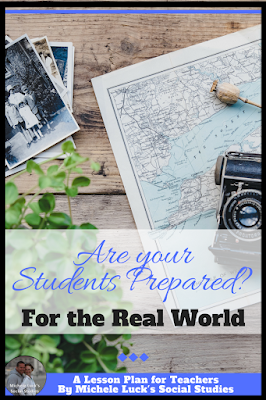Are your students prepared for the real world? Are they academically equipped to handle the twists and turns in our modern society? Are they ready to face the challenges? Are they alert to the cons and dupes of our technology-based community? In my humble opinion… No!
As a Social Studies teacher, I often started my school year fielding the questions, “Why do we have to take this class?” “What good will it do me in the future?” “How is Social Studies important?”
I always responded with a full explanation that my lessons would help prepare them for our modern world; I promised, that if they paid attention and actually learned my lessons, they would not be naive to those less scrupulous in our society.
So, what did I teach to keep this promise? I taught Geography, History, Sociology, Women’s Studies, and a semester course on the Holocaust. I taught them about humanity, social cooperation, compromise. I taught them that history is full of stories about those who failed to learn about the past, and therefore repeated the same mistakes. And I taught them that, through careful observation, and some basic knowledge, you can avoid the naivety that is common for so many.
What are the basics of these lessons?
Hmmm, let me think…
Okay, here we go; the big three:
- You have to look close to see the truth. Analyze images and question everything. Don’t ever trust information handed to you; verify the source and check for bias.
- You have to know the facts before you can make educated assumptions. Basic Social Studies skills can set a foundation to help you address many situations and suggestions.
- You have to know your world. This one takes time and dedication. Learn about the world, its physical and social geography, and the basic differences between you and I.
Now, see if it works…

Can you tell the truth about this image?
Sadly, this image came onto my Facebook feed with thousands of comments from those huddled in their homes on a cold January day. Those commenting generally agreed that they were glad they were not there in that image. Some made comparisons to their home city or state (comparing it to the COUNTRY of Canada). Most accepted the image and the title without question.
Look closer? What clues you in to the fact that this image is a fake?
It’s not the snow or its depth.
It’s not the trees peeking out from the top.
It’s not the carefully cut, high walls, creating the pathway through the packed precipitation.
It IS the road. It’s the cards on the road. It’s the directions being driven by the cars. Got it yet?
Or do you need a basic geography review? And maybe a lesson on Canada (and Europe, hint!)?
But we all take information fed to us in such quantity for granted these days. We accept it as truth, post our two-cents worth, and move on to the next topic for information. So, are we preparing our students (or even ourselves) for our modern world? An even better question: Are we prepared for what the future will bring?
What do you really know about the world that is so much in our news today? Hmmm…
Geography of Middle East
Geography of Asia
Geography of Africa

Happy Teaching!